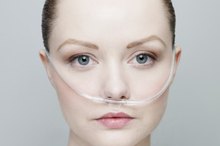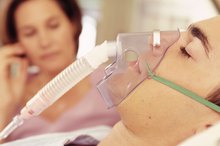What Are the Side Effects of Oxygen Therapy?
Air hunger is one of the most distressing of all medical symptoms. Patients who can't derive enough oxygen from the air they breathe typically suffer from this symptom. Oxygen therapy involves supplying an increased concentration of oxygen to the lungs, helping alleviate breathlessness. Patients with acute and chronic lung diseases, such as pneumonia, cystic fibrosis and COPD, and people with advanced heart failure commonly benefit from oxygen therapy. Although oxygen therapy is usually safe and effective when used as prescribed, side effects can occur in some patients.
If you are experiencing serious medical symptoms, seek emergency treatment immediately.
Nasal Irritation
Many patients get supplemental oxygen through a nasal cannula--flexible plastic tubing with prongs that fit into the nose. Over time, the cannula may irritate the lining of the nose, causing soreness or occasional bleeding. A nasal cannula of a different style or size, or changing to a face mask oxygen delivery system, alleviates this problem for most patients.
- Many patients get supplemental oxygen through a nasal cannula--flexible plastic tubing with prongs that fit into the nose.
- A nasal cannula of a different style or size, or changing to a face mask oxygen delivery system, alleviates this problem for most patients.
Diminished Respiratory Drive
The Effects of Mouth Breathing While on Oxygen
Learn More
The brain respiratory center monitors levels of oxygen and carbon dioxide in the blood 1. The level of carbon dioxide in the blood normally serves as the primary stimulant for the breathing. In some patients with chronic obstructive pulmonary disease, or COPD, the blood oxygen level becomes the primary stimulator of the respiratory rate, a phenomenon known as hypoxic respiratory drive.
Among patients with hypoxic respiratory drive, oxygen therapy may lead to depressed breathing. Starting patients with hypoxic respiratory drive on a low concentration of supplemental oxygen typically helps avoid this potentially serious side effect of oxygen therapy.
- The brain respiratory center monitors levels of oxygen and carbon dioxide in the blood 1.
- Starting patients with hypoxic respiratory drive on a low concentration of supplemental oxygen typically helps avoid this potentially serious side effect of oxygen therapy.
Pulmonary Oxygen Toxicity
When it comes to oxygen therapy, there can be too much of a good thing. Prolonged administration of highly concentrated oxygen can potentially damage the lung lining tissues and air sacs, a condition known as pulmonary oxygen toxicity. The risk for this side effect of oxygen therapy comes into play primarily when patients on home treatment increase the oxygen flow rate to a level higher than prescribed.
The risk of pulmonary oxygen toxicity proves highest when inhaling pure oxygen for several hours to days. Coughing is typically the first symptom of pulmonary oxygen toxicity. Irritation of the large airways caused by the highly concentrated oxygen provokes this symptom. With continued exposure, damage to the lung tissues may cause fluid leakage into the air sacs, accompanied by increasingly severe shortness of breath.
- When it comes to oxygen therapy, there can be too much of a good thing.
- With continued exposure, damage to the lung tissues may cause fluid leakage into the air sacs, accompanied by increasingly severe shortness of breath.
Related Articles
References
- Non-Invasive Respiratory Support Techniques; Glenda Esmond and Christine Mikelsons; 2009
- Critical Care Medicine: Perioperative Management; Michael James Murray, M.D., et al., Editors; 2002
- Things to Know When Using Oxygen Therapy. American Lung Association. August 23, 2018
- The Long-Term Oxygen Treatment Trial Research Group. A Randomized Trial of Long-Term Oxygen for COPD with Moderate Desaturation. The New England Journal of Medicine. 2016;375(17):1617-1627. doi:10.1056/NEJMoa1604344.
- American Lung Association. Supplemental Oxygen. 2017.
- Shah SA, Velardo C, Farmer A, Tarassenko L. Exacerbations in Chronic Obstructive Pulmonary Disease: Identification and Prediction Using a Digital Health System. Eysenbach G, ed. Journal of Medical Internet Research. 2017;19(3):e69. doi:10.2196/jmir.7207.
- Turan O, Ure I, Turan PA. Erectile dysfunction in COPD patients. Chron Respir Dis. 2016;13(1):5–12. doi:10.1177/1479972315619382
- Traveling with Oxygen. American Lung Association. October 3, 2018
- Nishimura M. High-flow nasal cannula oxygen therapy in adults. J Intensive Care. 2015;3(1):15. Published 2015 Mar 31. doi:10.1186/s40560-015-0084-5
- Abdo WF, Heunks LM. Oxygen-induced hypercapnia in COPD: myths and facts. Crit Care. 2012;16(5):323. Published 2012 Oct 29. doi:10.1186/cc11475
- American Thoracic Society. Patient Education Information Series. Oxygen Therapy. 2016.
Writer Bio
Dr. Tina M. St. John owns and operates a health communications and consulting firm. She is also an accomplished medical writer and editor, and was formerly a senior medical officer with the U.S. Centers for Disease Control and Prevention. St. John holds an M.D. from Emory University School of Medicine.









